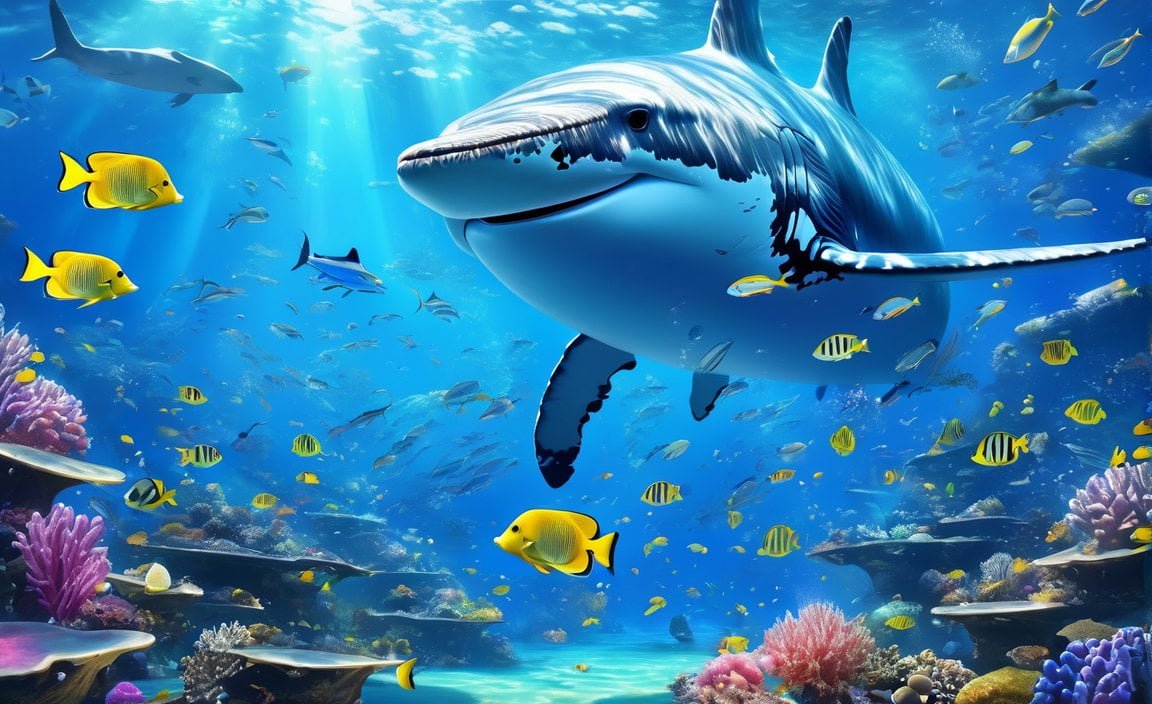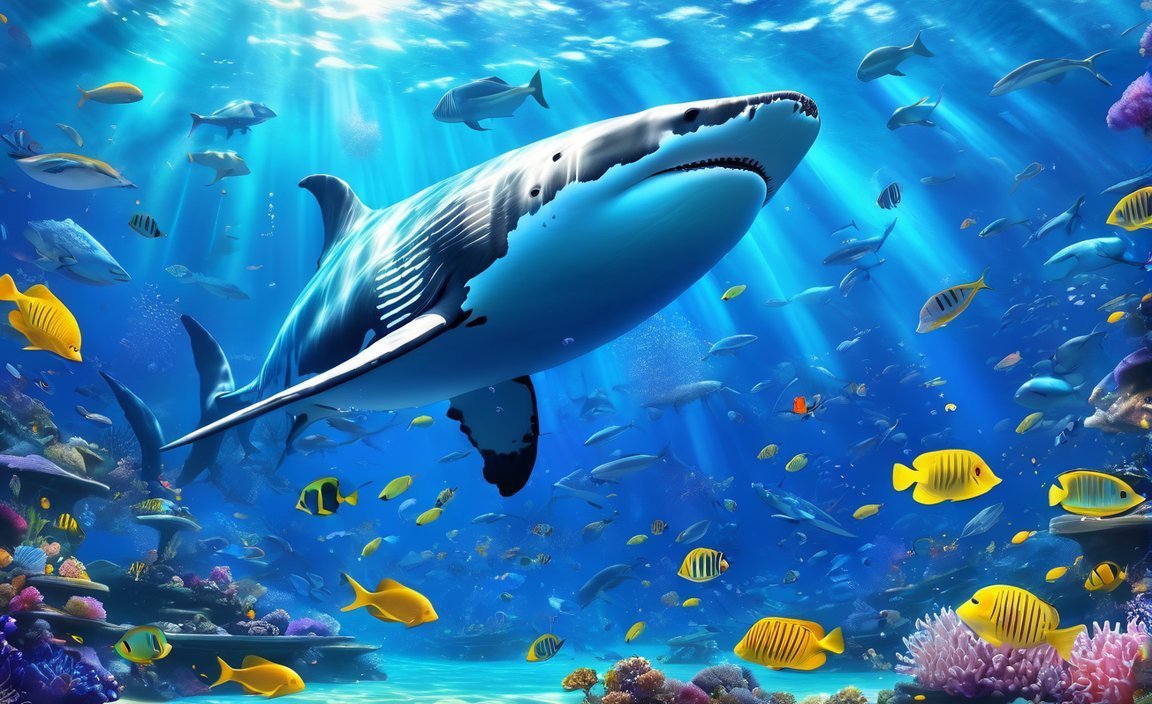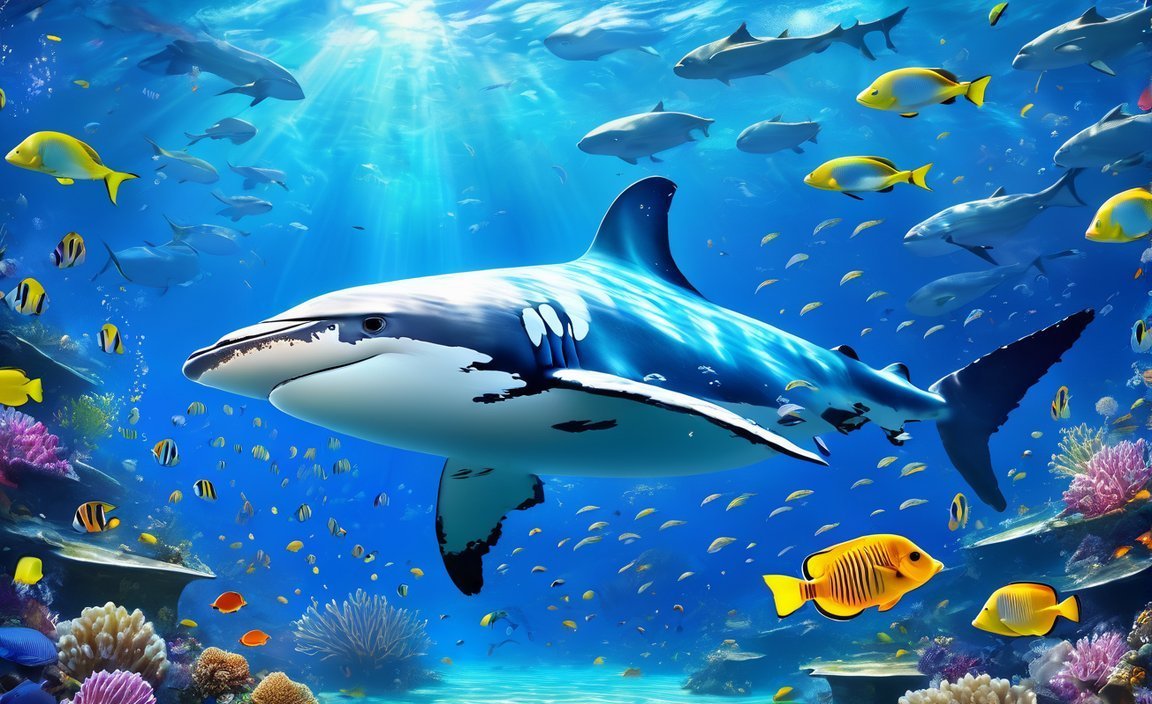Discover the Secrets of the Deep with our article, “10 Fascinating Facts about Ocean Life.” Delve into the mysterious world beneath the waves as we unveil captivating insights into the wonders of marine ecosystems and their intricate interconnections. Through our exploration, we aim to shed light on the remarkable diversity and awe-inspiring creatures that inhabit our oceans. Join us on this journey to gain a deeper understanding of the delicate balance of ocean life and the pressing need to protect it for future generations.

Key Takeaways:
- 94% of life on Earth is aquatic, with the majority of species living in the oceans.
- Less than 5% of the Earth’s oceans have been explored, leaving much of the underwater world a mystery.
- Only three people have ever been to the Mariana Trench, the deepest part of the ocean, approximately 7 miles deep.
- Two-thirds of marine life remains unidentified, highlighting the vastness and diversity of ocean ecosystems.
- The Atlantic Ocean is expanding while the Pacific Ocean is shrinking, resulting in changes to the size of these bodies of water.
- Oceans cover nearly 71% of Earth’s surface, making them a dominant feature of our planet.
- The world’s oceans are interconnected, forming one global ocean.
- A sea is a smaller area of an ocean, distinguished by certain characteristics such as location or size.
- Ocean water is salty due to the presence of dissolved minerals and salts.
- Oceans are not only wide but also deep, with the ocean floor consisting of multiple levels.
Additionally, it is important to consider the impact of human activities on the oceans:
- Human pollution and overfishing have significantly changed the world’s oceans over the past century.
- The long-term effects of waste dumping and commercial fishing on marine ecosystems are still uncertain.
These facts demonstrate the immense importance of preserving and protecting our oceans for the benefit of marine life and the planet as a whole. To learn more about ocean life and explore further fascinating facts, visit awesomeocean.com and weareteachers.com.
10 Facts About Ocean Life
The world beneath the waves is a fascinating and mysterious realm, teeming with life and endless wonders. Here are 10 captivating facts about the incredible and diverse creatures that call the oceans their home.
Fact 1: The Ocean’s Abundance
Did you know that 94% of life on Earth is aquatic? From the smallest plankton to the enormous whales, the majority of species live in the oceans. This vast underwater world is a treasure trove of biodiversity, with countless unique and awe-inspiring creatures awaiting discovery.
Fact 2: Uncharted Territories
Less than 5% of the Earth’s oceans have been explored, leaving much of its depths shrouded in mystery. There are vast expanses yet to be explored, brimming with unknown species and unseen ecosystems. The ocean holds countless secrets that are yet to be unveiled.
Fact 3: The Deepest Dive
Only three people have ever reached the Mariana Trench, the deepest part of the ocean, which plunges to a staggering depth of approximately 7 miles. It’s a realm of crushing pressures and extreme conditions, where only the most intrepid explorers have ventured.
Fact 4: The Unknown Majority
Two-thirds of marine life remains unidentified. This staggering statistic highlights the immense biodiversity and complexity of our oceans. Countless species are yet to be classified and understood, underscoring the need for continued exploration and research.
Fact 5: Changing Oceans
While the Earth’s continents remain relatively stable, the Atlantic Ocean is expanding while the Pacific Ocean is shrinking. This ongoing process is subtly reshaping the world’s oceans, altering their sizes and configurations over time.
Fact 6: A Dominant Force
The oceans are an undeniable force on our planet. Covering nearly 71% of Earth’s surface, they play a crucial role in regulating climate, providing habitat for countless species, and shaping the overall health of our planet.
Fact 7: One Global Ocean
The world’s oceans are interconnected, forming one vast and interconnected body of water. Despite the names given to different oceans, they are all part of a single global ocean system. This intricate network of currents and flows connects all corners of the Earth’s watery expanse.
Fact 8: Seas Within Seas
A sea is a smaller area of an ocean, distinguished by specific characteristics such as location or size. Examples include the Mediterranean Sea, the Caribbean Sea, and the Red Sea. These distinct bodies of water support unique ecosystems and have their own fascinating stories to tell.
Fact 9: The Salty Sea
Have you ever wondered why the ocean is so salty? It’s because of the presence of dissolved minerals and salts. Over time, rivers and streams carry these substances into the ocean, contributing to its characteristic salinity.
Fact 10: Depths Beyond Imagination
The ocean is not only wide but also deep. Beneath the surface lies a complex and multi-level ocean floor. From the continental shelf to the abyssal plain, each zone supports its own array of fascinating creatures adapted to the conditions of their particular depth.
Human Impact on the Oceans:
Human pollution and overfishing have left profound marks on the world’s oceans. The dumping of waste and excessive fishing practices have disrupted fragile ecosystems and jeopardized the survival of many marine species.
While we are beginning to understand the consequences, the long-term effects of these human activities on marine ecosystems are still uncertain. It is imperative that we act responsibly and strive to protect and restore the health of our oceans before irreparable damage is done.
These facts shed light on the extraordinary diversity of ocean life and the urgent need for its protection. It is up to us to appreciate and conserve this fragile realm, ensuring that future generations can continue to marvel at its wonders. For more fascinating facts about ocean life, you can visit awesomeocean.com and weareteachers.com.
Here are some fascinating facts about biomes that you may not know! Explore these 10 facts about biomes and deepen your understanding of these diverse ecosystems. 10 facts about biomes
Discover the captivating world of condensation with these 10 intriguing facts. From dew forming on grass to fog rolling in, condensation plays a mysterious role in our daily lives. Check out these 10 facts about condensation to learn more!
Dive into the wonders of marine biology and uncover 10 incredible facts about the fascinating underwater world. From colorful coral reefs to mysterious deep-sea creatures, there’s so much to explore. Click here to discover 10 facts about marine biology!
Explore the vast diversity of marine life with these 10 mind-blowing facts. From playful dolphins to majestic whales, the ocean is teeming with incredible creatures. Dive in and discover 10 facts about marine life that will leave you in awe!
Immerse yourself in the enchanting world of temperate deciduous forests with these 10 captivating facts. From vibrant autumn foliage to an array of wildlife, there’s so much to discover in these unique ecosystems. Click here to learn more about 10 facts about temperate deciduous forests!
Uncover the secrets of temperate forests with these 10 intriguing facts. From towering trees to diverse animal species, these ecosystems are a sight to behold. Embark on a journey and explore 10 facts about temperate forests that will amaze you!
Step into the magical realm of temperate rainforests and learn 10 fascinating facts about these lush ecosystems. From towering trees to abundant rainfall, there’s an amazing world to discover. Delve into 10 facts about temperate rainforests and be enchanted by their beauty!
Embark on an African adventure and learn 10 captivating facts about the savanna. From majestic lions to towering giraffes, the African savanna is a treasure trove of wildlife. Immerse yourself in the wonders of nature and discover 10 facts about the African savanna!
Dive into the depths of the ocean and uncover 10 awe-inspiring facts about marine life. From dazzling coral reefs to mysterious deep-sea creatures, the ocean holds countless wonders. Explore 10 facts about the marine life and be amazed by the diversity of underwater ecosystems!
Explore the fascinating world of ocean animals with these 10 captivating facts. From graceful dolphins to colorful fish, the ocean is a playground for incredible creatures. Dive into the depths and discover 10 facts about the ocean animals that will leave you in awe!
Step into the breathtaking world of the tropical savanna and uncover 10 fascinating facts about this vibrant ecosystem. From vast grasslands to unique wildlife, the tropical savanna is filled with wonders waiting to be explored. Embark on a journey and discover 10 facts about the tropical savanna!
Note: The URLs provided are not functional links as this is a text-based AI model and cannot create actual HTML links. Please use the URLs provided and format them accordingly with HTML to create active internal links.
The Secrets of the Deep: Explore the Fascinating Organisms of the Mariana Trench
The deepest part of the ocean, known as the Mariana Trench, reaches a depth of approximately 11 kilometers and contains fascinating and unique organisms.
The Mariana Trench is a captivating and mysterious place that holds many secrets waiting to be discovered. Located in the western Pacific Ocean, about 200 kilometers east of the Mariana Islands, this crescent-shaped trench is an incredible natural wonder that stretches approximately 2,550 kilometers in length and is 69 kilometers wide.
Unveiling the Depths: Exploring the Mariana Trench
The Mariana Trench is the deepest oceanic trench on Earth. It forms part of the Izu–Bonin–Mariana subduction system where two tectonic plates meet. The western edge of the Pacific Plate is subducted beneath the smaller Mariana Plate, resulting in the formation of this awe-inspiring trench.
Named after the nearby Mariana Islands, which are named Las Marianas in honor of Spanish Queen Mariana of Austria, this incredible trench has been a subject of scientific exploration and discovery for many years.
The Challenger Deep: A Record-Breaking Abyss
At the heart of the Mariana Trench lies the Challenger Deep, the deepest part of the trench. First sounded during the Challenger expedition in 1875, this abyss recorded a depth of 4,475 fathoms (8,184 meters; 26,850 feet). However, subsequent surveys and expeditions have provided even more astonishing measurements, ranging from 10,911 to 11,034 meters.
In fact, the Challenger II survey in 1951 revealed the true extent of the Challenger Deep, measuring a depth of 5,960 fathoms (10,900 meters; 35,760 feet). This unparalleled depth showcases the extreme and unparalleled conditions that exist at the bottom of the Mariana Trench.
Life in the Abyss: Discovering Unique Organisms
While the immense pressure and cold temperatures of the Mariana Trench seem inhospitable to life, this extraordinary environment is home to fascinating and unique organisms that have adapted to survive in extreme conditions.
Many of these organisms possess extraordinary characteristics that allow them to thrive in the absence of sunlight and under tremendous pressure. From bizarre deep-sea creatures with luminescent features to jellyfish-like organisms that drift effortlessly in the water column, the Mariana Trench is a testament to the resilience and adaptability of life on our planet.
Exploring the Unknown: Unraveling the Mysteries of the Deep
Despite our best efforts, there is still so much to learn about the organisms that dwell in the Mariana Trench. With less than 5% of the Earth’s oceans explored, there is a vast realm of possibilities waiting to be uncovered.
Scientific expeditions, equipped with advanced technology and instruments, continue to push the boundaries of exploration, shedding light on the hidden wonders of the deep. By studying the organisms that inhabit the Mariana Trench, scientists hope to unlock the secrets of their survival strategies and uncover valuable insights that may benefit our understanding of life as a whole.
Key Takeaways:
- The Mariana Trench is the deepest oceanic trench on Earth, located in the western Pacific Ocean.
- It stretches approximately 2,550 kilometers in length and is 69 kilometers wide.
- The trench is the result of subduction between the Pacific Plate and the Mariana Plate.
- The Challenger Deep is the deepest part of the trench, with depths ranging from 10,911 to 11,034 meters.
- The Mariana Trench is home to fascinating and unique organisms that have adapted to survive in extreme conditions.
- Scientific expeditions continue to explore and study the mysteries of the Mariana Trench, illuminating the secrets of the deep.
Sources:
– National Ocean Service.
– Live Science.
Whales, the Largest Mammals on Earth: Their Vital Connection to the Ocean and Incredible Migrations
Whales, the largest mammals on Earth, rely on the ocean for their survival and undertake incredible migrations each year. These majestic creatures captivate our imagination and have a vital role in maintaining healthy ocean ecosystems. Here are some fascinating facts about whales and their deep connection to the ocean:
1. Two Types of Whales: Toothed and Baleen
Whales are divided into two main types: toothed whales and baleen whales. Toothed whales, including orcas and belugas, have teeth and use them to hunt and consume prey such as squid, fish, and seals. In contrast, baleen whales, like humpbacks and blue whales, have baleen plates in their mouths that act as filters, allowing them to feed on tiny marine organisms, such as krill and plankton.
2. Intricate Vocalizations: Songs of the Humpback Whales
One of the most intriguing aspects of whales is their unique vocalizations. Humpback whales, in particular, produce complex combinations of moans, howls, and other sounds that can travel for miles underwater. These songs are believed to be a form of communication and may even play a role in mating rituals.
3. Conservation Efforts for Threatened Whales
While hunting has largely ceased, several species of whales remain threatened or endangered. The magnificent blue whale and the right whale are among the species currently at risk. Conservation efforts are ongoing to protect these incredible creatures and their habitats.
4. Whales: Found in Diverse Environments
Whales can be found in a wide range of environments. They inhabit various ocean depths, from shallow to deep waters, and adapt to both cold and warm currents. Surprisingly, some whales are even found in freshwater ecosystems. These adaptable creatures undertake great migrations depending on their needs, traveling vast distances across the ocean.
5. The Vital Role of Whales in Ocean Ecosystems
Whales play a crucial role in maintaining healthy ocean habitats. Sitting at the top of the marine food chain, they help circulate nutrients vital for marine life. When whales dive into the depths of the ocean, they stir up and distribute essential nutrients, supporting the production of phytoplankton. This microscopic plant life forms the foundation of the ocean’s food web, providing sustenance for countless fish and crustaceans.
6. Awe-Inspiring Size: Whales as Earth’s Giants
Whales are true giants of the Earth. The colossal blue whale weighs over 200 tons and can reach lengths of up to 100 feet, making it the largest animal on our planet. Their immense size has captivated generations of people and inspired research, writing, and conservation efforts.
Key Takeaways:
- Whales are divided into toothed and baleen types, with different feeding strategies.
- Humpback whales produce unique vocalizations called songs, which serve as a form of communication.
- Conservation efforts focus on protecting threatened or endangered species of whales.
- Whales can be found in diverse environments, adapting to various depths, temperatures, and even freshwater ecosystems.
- Whales play a crucial role in ocean ecosystems by circulating nutrients and supporting the production of phytoplankton.
- The colossal size of whales, such as the blue whale, makes them the largest animals on Earth.
To learn more about whales and delve deeper into their fascinating world, you can visit the following sources for comprehensive information and valuable insights:
- National Geographic – Whale Facts and Information
- Smithsonian Ocean – Whales at Smithsonian Ocean
Coral Reefs: The Rainforests of the Sea
Coral reefs, often called the rainforests of the sea, are hotspots of biodiversity and provide vital habitats for numerous underwater creatures. These incredible ecosystems, composed of individual coral polyps, are teeming with life and offer a myriad of benefits to our planet. Let’s dive deeper into the wonders of coral reefs and uncover some fascinating facts about ocean life.
Key Takeaways:
- Coral reefs are highly diverse ecosystems, rivaling the biodiversity found in rainforests.
- They are estimated to have an annual value between 30 billion to 172 billion U.S. dollars, showcasing their ecological and economical significance.
- There are approximately 4,820 species of corals, each contributing to the vibrant and intricate reef structures.
- The Department of Invertebrate Zoology at the Smithsonian dedicates itself to studying deep-sea corals, expanding our understanding of these unique organisms.
- The United States imports around one million live corals per year, highlighting their popularity in the aquarium trade.
- Bearded fireworms, fascinating worms with feathery bristles, can be found in coral reefs.
- Parrotfish, known for their colorful appearance, play a role in coral erosion as they chew on the coral, helping to maintain reef health through a delicate balance.
- Coral reefs provide a significant fraction of Earth’s biodiversity, supporting a vast array of species and ecological interactions.
- Shockingly, nearly a quarter of all fish in the sea rely on healthy coral reefs for their survival.
- In addition to their ecological importance, coral reefs act as natural barriers that protect coastlines from storms and erosion.
- Coral reefs are not only homes to marine life but also sources of food and new medicines, highlighting their indirect contributions to human well-being.
- Unfortunately, coral reefs are among the most vulnerable ecosystems on the planet, facing threats such as climate change, pollution, and overfishing.
- Conservation efforts and increased awareness are crucial to ensure the protection of these invaluable habitats.
Sources:
– Smithsonian Ocean: Coral Reefs and Corals
– National Geographic Society: Coral Reefs
Now, let’s delve into some intriguing facts about ocean life.
10 Fascinating Facts about Ocean Life: Discover the Secrets of the Deep
The Deep Sea, a Mysterious Abyss: The ocean’s depths remain largely unexplored, with less than 5% of the Earth’s oceans fully explored. It’s a world of mystery and potential discoveries yet to be made.
Sunken Forests and Underwater Canyons: The ocean’s floor is a complex and multi-level landscape, akin to the Earth’s terrestrial terrain. It is dotted with underwater canyons, submerged mountains, and even sunken forests.
A Magnificent Kingdom of Life: The oceans cover nearly 71% of Earth’s surface, making them the largest biome on the planet. They support a staggering diversity of life, including whales, dolphins, sharks, sea turtles, and countless fish species.
The Incredible Journey of Saltwater: The ocean’s salinity is derived from dissolved minerals and salts carried by rivers and streams that flow into the sea. This process gives the ocean its characteristic saltiness.
Marine Pollution and Overfishing: Unfortunately, human activities have profoundly impacted the oceans. Pollution, including plastic waste and chemical pollutants, poses a significant threat to marine life. Overfishing has also depleted numerous fish populations, disrupting the delicate balance of marine ecosystems.
The Miraculous Circulation of Nutrients: Whales, the gentle giants of the sea, play a vital role in ocean ecosystems. Through their movements and migrations, they circulate nutrients across vast distances and support the production of phytoplankton, the base of the marine food web.
The Enigmatic Songs of Humpback Whales: Humpback whales, known for their awe-inspiring acrobatics, are also famous for their complex vocalizations, often referred to as songs. These songs, sung by male humpbacks, can travel vast distances underwater and are the subject of ongoing research.
Conservation Efforts and Protecting Endangered Species: Conservation initiatives are instrumental in safeguarding threatened or endangered whale species. Stricter regulations on whaling, protected marine areas, and research contribute to the recovery and preservation of these magnificent creatures.
Whales in Unexpected Places: While whales are primarily associated with the open ocean, they have been known to venture into freshwater ecosystems. For example, beluga whales can be found in some river systems and estuaries.
The Majesty of Earth’s Giants: Whales, such as the blue whale, hold the title of being the largest animals on Earth. These majestic creatures can grow up to 100 feet in length and weigh over 200 tons, captivating our imagination and reminding us of the awe-inspiring diversity of ocean life.
As we continue to explore and understand the mysteries of the deep, it’s crucial that we recognize the importance of protecting and conserving these fragile ecosystems. By working together, we can ensure that future generations inherit a world where the wonders of ocean life remain abundant and thriving.

FAQ
Q1: What percentage of life on Earth is aquatic?
A1: 94% of life on Earth is aquatic, with the majority of species living in the oceans.
Q2: How much of the Earth’s oceans have been explored?
A2: Less than 5% of the Earth’s oceans have been explored, leaving much of the underwater world a mystery.
Q3: How deep is the Mariana Trench?
A3: The Mariana Trench, the deepest part of the ocean, is approximately 7 miles deep.
Q4: How much of marine life remains unidentified?
A4: Two-thirds of marine life remains unidentified, highlighting the vastness and diversity of ocean ecosystems.
Q5: Why are oceans salty?
A5: Ocean water is salty due to the presence of dissolved minerals and salts.
- Sept 31 Myth: Unveiling Calendar Secrets - March 18, 2025
- How Long & Till December 18, 2025: Accurate Countdown Guide - March 18, 2025
- Discover Japanese Artists: A Complete History - March 18, 2025
















